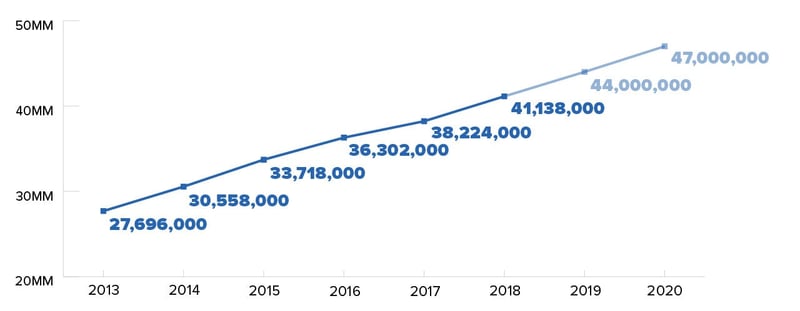Whether in the on-demand sector or more traditional industries, companies across the board are finding it increasingly difficult to keep ahold of their most valuable assets - their people.
Though executives attribute 72% of their company’s value to their employees, Work Institute, a Tennessee based consulting firm found 41 million people voluntarily quit their jobs in 2018, which was a 8% increase from 2017. Their estimates are that this year, the number will have risen to 47 million or roughly 1 in 3 workers.

Source: U.S. Bureau of Labor Statistics; Work Institute.
Not only is turnover a loss to a company in terms of the unique skills, knowledge and experience a churned employee takes with them when they leave, but it’s a huge financial hit too. Gallup estimated that the cost of replacing a single employee ranges from ½ to 2x their salary.
So, what is the implication of this for businesses? Is the outlook really so bleak? Can anything be done to remedy it?
Read on for the lay of the land in numbers when it comes to employee retention in 2020...
1. 16% of Gen Z and Millennial employees have quit a job because they felt the technology provided by their employer was inadequate
Millennials (early 1980s-mid 1990s) and Gen Z (mid 1990s-late 2000s) are growing to make up the global workforce in greater numbers.
It’s estimated Millennials will make up 75% of the global workforce by 2025. These generations have differing expectations of employers than their predecessors. They put greater emphasis on things like empathy, purposefulness, personal development and flexibility.

Having grown up in tandem with the smartphone and social media boom, they have been weaned on technology. As a result, they carry certain technological expectations when selecting - and staying - at a workplace.
To retain Millennial and Gen Z talent, employers must stay abreast of the latest innovations and tools with which to effectively communicate, recognise, train and engage these tech savvy demographics.
2. Highly engaged business units experience 59% less employee turnover
The link between employee engagement and retention is well established. Employees who are highly engaged are 87% less likely to leave an employer.

This is because engaged employees are invested in your vision, and committed to turning it into a reality. They work productively and with purpose. They show up to work and do more of it - Gallup found a 41% reduction in absenteeism among engaged employees, and a 17% increase in productivity.
Engaged employees enthusiastically oversee successful business outcomes - businesses units that score in the top percentile of employee engagement are 2x more likely to succeed. Their passion is contagious - they consistently delight customers, exhibiting a 10% higher level of customer service and 20% increase in sales than non-engaged counterparts.

Source: Kevin Kruse via Forbes
3. Companies rated highly on employee training saw 53% lower attrition
So the statistics indicate that employee engagement is a prerequisite for lowering churn. But what engages employees?
Employee engagement is tapped into when your people feel empowered to perform at their very best. So the first step on the path to improved engagement is to make sure your people have access to the information, tools and knowledge they need to succeed, when they need it.
Once they have the knowledge they need to succeed in the palm of their hands, they feel capable to act confidently and independently in completing daily tasks, and are motivated into productivity.
4. Companies rated highly on ‘purposeful mission’ saw 49% lower attrition
Humans are purposeful by nature - it is meaning that drives our actions. This extends to the world of work. When your employees find genuine meaning and purpose in what they do, they are motivated to do it, and feel fulfilled in the process.
Employees with a sense of purpose understand why they come into work every day, and how every micro-task, that when looked at in isolation may seem trivial or insignificant, is meaningful and fits into a larger picture.

But purposeful employees don’t just materialize, they are made. Every company has a rationale for existence. To inspire meaning, you need to nurture peoples’ sense of purpose, by building correlation between today’s actions and tomorrow’s vision.
5. 90% of workers said they are more likely to stay at a company that takes and acts on feedback
Employees are the lifeblood of a company, so to succeed, their input should be routinely and proactively sought.
A proactive approach to collecting feedback is a mutually beneficial practice. It increases employee engagement (which increases employees performance). Employees that feel heard are 4.6x more likely to perform at their very best.
Additionally, it is an easy way for employers to ascertain areas for improvement in terms of training, informing and engaging their people. Collecting feedback illuminates knowledge gaps, motivates employees and encourages reflection - in employees and employers - that leads to positive change for both parties.
Overall, surveying employee sentiment is an easy and highly valuable way for employers to keep a finger on the pulse of their workforce, and identify how they can better train, inform and engage their people.
The takeaway...
If you invest in the right tools and technology, make engaging your workforce a business priority, empower your people with a voice to be heard, and entrench purpose as a cornerstone of your company’s culture, you stand to win.
As employers, the power lies in your hands to shape the outcome you desire in terms of employee loyalty, engagement and retention.
And it starts with recognising that your success is tied up in the success of the individuals that make up the collective
When you empower your people with the training, information and engagement they need to perform at their very best, their success is secured. And it is the success of individuals that affords the success of the whole business unit - or, Workforce Success.
Looking to deliver accessible, point-of-need information and training to engage and empower your freelancers, employees, contractors or clients?







